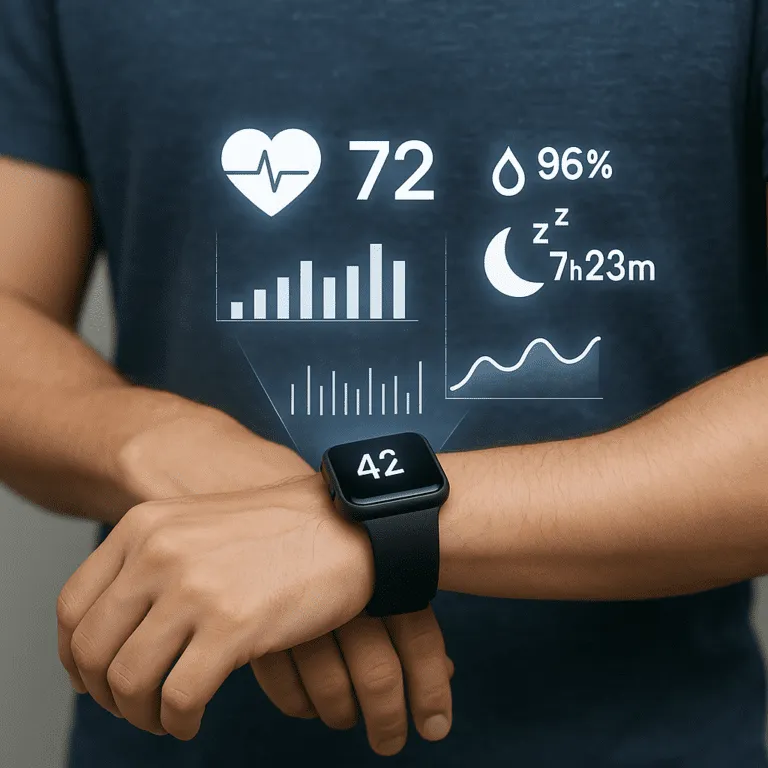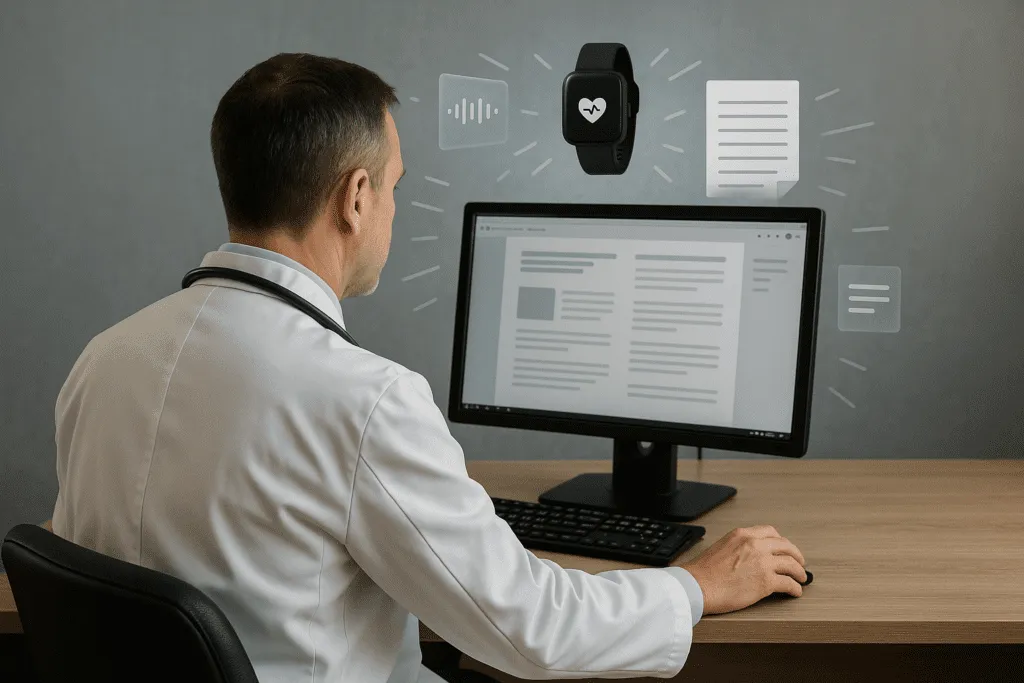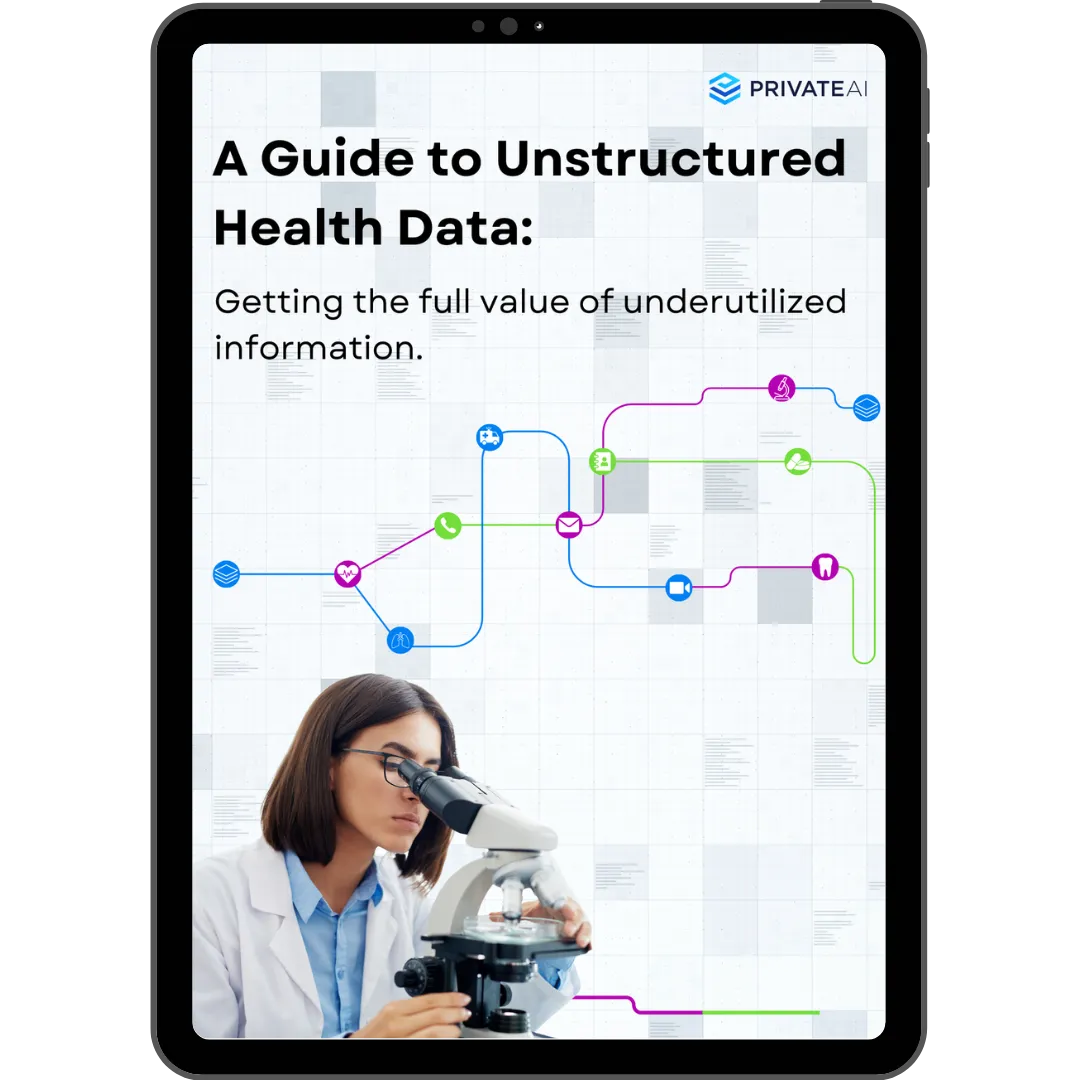
The way healthcare organizations collect and use critical data is changing, and changing fast. From smartwatches to AI-powered documentation, new technologies are transforming how patient information flows, creating new opportunities for continuous health monitoring, early intervention, and improved clinical outcomes. But with so many tools entering the space, it can be hard to keep up.
Let’s break down some of the most impactful new ways organizations are collecting health data–and how they are leveraging it.
Ambient Listening: Less Typing, More Care
Clinicians didn’t sign up to be scribes, but at the same time, they don’t want to miss any potential life-saving information that could be shared in a patient-provider conversation. Ambient listening technology is stepping in to solve that.
Ambient listening “listens” to patient visits and automatically creates accurate summaries, generates billing and diagnostic codes, and automatically drafts orders for labs, prescriptions, and follow-up appointments. The technology is designed specifically for healthcare environments, trained to understand medical terminology and context. It goes beyond simple audio recording: it interprets the content and meaning of the dialogue. The result? Clinicians have more face time with patients and less time glued to a keyboard.
A survey led by the Medical Group Management Association (MGMA) found that:
- 42% of medical group leaders are already using some form of ambient AI solution. However, the majority of those are using it simply for visit transcription or speech recognition, while only 29% use it for clinical note generation, and 21% have an AI documentation assistant.
- The vast majority (80%) of medical group leaders say they are very likely (53%) or somewhat likely (27%) to implement or update an ambient AI solution in the next 12 months.
This isn’t about replacing doctors. It’s about giving them back the time—and the focus—they need to deliver better care.
“It saves time and mental energy, allowing providers to concentrate on the patient and the conversation,” said Bob Murry, PhD, MD, FAAFP, chief medical officer, NextGen Healthcare, for MGMA.
Wearables & Smart Devices: Turning Daily Habits Into Health Insights

What used to live only in a clinic now lives on your wrist—or even in your toilet. From wearables to smart home systems, a wave of consumer-friendly technologies is quietly reshaping how health data is collected, understood, and used.
Wearable sensors like smartwatches and fitness trackers have gone mainstream—over a third of U.S. adults use them, with 43% wearing them daily. These devices continuously gather real-time data, such as heart rate, sleep patterns, and activity levels. For patients managing chronic conditions like diabetes or heart disease, this creates a stream of digital biomarkers—quantifiable insights into their day-to-day health. Rather than relying on isolated readings from a 10-minute doctor visit, providers can access a richer, continuous view of patient health.
This kind of data is brought by the patient to clinicians not to replace medical exams or clinical expertise, but to add meaningful context. It helps them better understand how a patient is doing outside the hospital walls and, in many cases, it encourages patients to seek care earlier. It's not a substitute for care; it's a complement that helps make care more timely, targeted, and effective.
And people are on board: nearly 80% of users say they’re willing to share their wearable data with healthcare providers to help drive better outcomes.
But health tracking is no longer limited to what you wear. Smart home devices are stepping in, often without the user having to do a thing. Take the smart thermostat, for instance: researchers at the University of Waterloo used data from ecobee thermostats, combined with AI algorithms from the UbiLab Public Health Surveillance Platform, to successfully monitor sleep, physical activity, and sedentary behavior. The kicker? The results were comparable to those from traditional, resource-heavy surveys conducted by public health agencies.
Even toilets are now capable of analyzing urine and stool (yes, you read that right, and yes, we had the same reaction), offering non-invasive ways to monitor hydration, nutrition, and gut health. Meanwhile, radar technologies originally developed for defense are now being used to track vital signs—no wires, no touch required.
These passive systems mark a shift toward home-based monitoring, where data is collected naturally from the environment, enabling more personalized care plans and long-term progress tracking. The benefits go beyond convenience—this type of data collection can be more cost-efficient, more scalable, and significantly faster in turning insights into action.
Together, these innovations speak to a larger trend: health data collection is moving closer to the patient and farther from the clinic. Whether it's from your wrist, your thermostat, or your toilet, the goal is the same: equipping doctors with high-quality, real-world data that helps deliver more proactive, personalized care.
Virtual Visits, Real Impact: Telemedicine as a Data Source
Healthcare is no longer limited to in-person visits. Patients now interact with their providers through screens, sensors, and digital touchpoints—whether it’s a telemedicine appointment, a chatbot, an online form, or a patient portal.
Telehealth saw an explosive 766% growth at the start of the COVID-19 pandemic. And it’s not just a passing trend—by early 2025, 83% of healthcare providers still support its use. Even more telling: 82% of patients say they prefer a hybrid model. Virtual visits save time, reduce stress, and make it easier to manage chronic care from the comfort of home.
But the benefits go beyond convenience. Digital interactions generate valuable patient-reported data that, when used effectively, can improve care. Patients can check lab results, message their care team, or request refills—all from a single platform. For those managing ongoing conditions, this kind of access can mean fewer burdensome trips to the clinic and better mental and physical health outcomes.
Used well, this data becomes a powerful tool—fueling personalized care, ongoing monitoring, and shared decision-making that actually meets people where they are.
The Challenge

Here’s the thing: Over 70% of physicians say they’re drowning in data without the tools or standards to manage it. All that powerful, patient-centered data we just talked about? The insights from wearables, telemedicine, ambient listening, and smart home devices? It doesn’t arrive neatly packaged in a spreadsheet. It’s text. It’s audio. It’s images. It’s… messy. In short, it’s unstructured data—and it now makes up 80% of all health data.
Unstructured data is hard to work with because it doesn’t follow a standard format. It lives in clinical notes, scanned documents, patient messages, imaging reports, and increasingly, from new digital sources like chatbots, app forms, and sensor feeds. That data is rich with insight—but locked behind layers of complexity.
For years, healthcare organizations either ignored it or relied on slow, manual processes to try and manage it. And traditional data tools? They weren’t built for this kind of data. Most either strip away too much value in the name of risk reduction or can’t process unstructured content at scale.
To make this information usable, you need to do three things:
- Discover what sensitive content is buried in your data (across text, audio, images, and more).
- Configure it with de-identification that’s smart enough to preserve the context that makes the data useful.
- Transform it into structured, AI-ready formats without losing what matters.
This isn’t just a technical hurdle—it’s a strategic one. Without the ability to make sense of unstructured health data, healthcare systems risk missing out on earlier diagnoses, more effective treatment plans, and major research breakthroughs. That’s why more organizations are turning to Critical Data Transformation: AI-powered solutions designed specifically to extract the value from this data without compromising security or patient trust.
Because while the future of healthcare is digital, it’s also increasingly unstructured. And the organizations that figure out how to activate it? They’ll be the ones who lead it.
Ready to activate the power of unstructured health data?

Download our free guide to learn how AI can help you turn clinical notes, audio, images, and more into secure, usable insights.






































































































